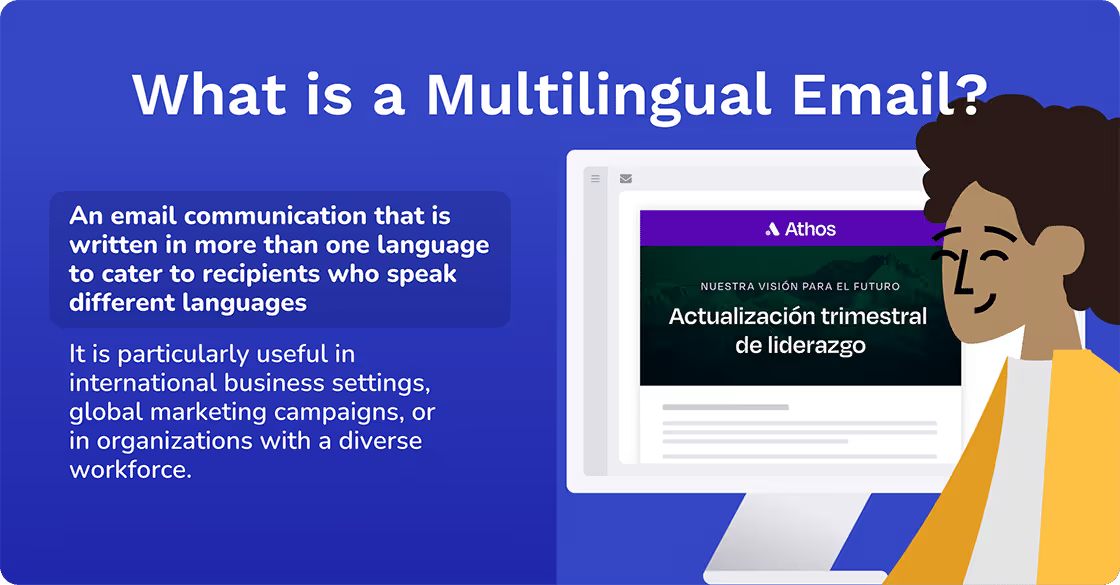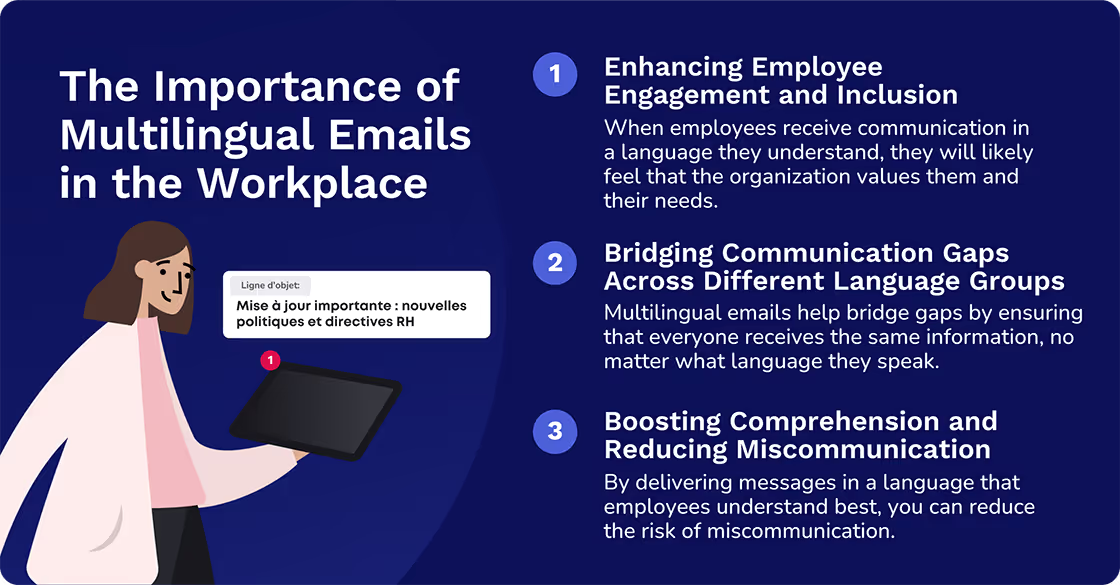 Employee Communication Best Practices
Employee Communication Best Practices
Multilingual Emails and Their Importance in Internal Communication
Any organization with employees that speak different languages need to embrace multilingual emails. We tell you why and how to do this by leveraging AI.


Enhance your DEI Communications
Communications around Diversity, Equity, and Inclusion (DEI) need to be strategic, thoughtful, and empathetic. Ensure your DEI communications are up to standards with our 4 step planning document.
Access NowMultiple languages in the global workplace enhance cultural diversity but also introduce challenges in communication and collaboration. Language differences can lead to misunderstandings. But, when managed effectively, they foster inclusivity and innovation. Embracing multilingual communication ensures that all employees, regardless of their native language, can contribute meaningfully to the organization's success.
According to Ethnologue, there are 7,164 “living languages” in the world today. The two most spoken languages are English (with the most speakers) and Mandarin Chinese (with the most native users). But these are not the first languages of many employees. According to their statistics, approximately:
- 1.515 billion people speak English, but for 1.135 billion, it is a second language.
- 1.140 billion people speak Mandarin Chinese, mostly as their native language (941 million).
According to the U.S. Census Bureau's American Community Survey data, approximately 8.2% of the U.S. population does not speak English or speaks it less than "very well.” The World Population Review highlights that this percentage represents individuals who primarily speak a language other than English at home and have limited English proficiency.
Lingoda states that globally, about 6.5 billion people do not speak English as their first language. This leaves a significant portion of the global population — around 77% — who either do not speak English at all or do not use it as their primary language.
These statistics highlight the linguistic diversity across the globe and underscore the importance of multilingual communication.
Email is a good place to start — and Cerkl Broadcast’s new Blast Translations feature enables users to translate their emails instantly. By leveraging artificial intelligence (AI), Blast Language Translations (Beta) delivers accurate translations and adapts the content to suit the cultural context, making your internal communication more effective and inclusive.
Free DEI Communications Checklist to Foster Inclusion
Ensure your company's communications promote diversity, equity, and inclusion

Download Free
What is a Multilingual Email?
A multilingual email is an email communication that is written in more than one language to cater to recipients who speak different languages. It is particularly useful in international business settings, global marketing campaigns, or in organizations with a diverse workforce. The goal of a multilingual email is to ensure that the message is accessible and understandable to all recipients, regardless of their primary language.
To effectively navigate the complexities of a multilingual global workforce, companies need to recognize the importance of tailored communication strategies in overcoming linguistic barriers. Multilingual emails are essential for addressing the diverse linguistic needs of employees, ensuring that each message is clear, inclusive, and aligned with the specific requirements of the organization.

The Importance of Multilingual Emails in the Workplace
In today's increasingly globalized workplace, multilingual emails are essential for fostering clear communication, inclusivity, and collaboration among diverse teams. They help bridge language barriers, reduce misunderstandings, and create a more inclusive environment where every team member feels valued and informed.
Enhancing Employee Engagement and Inclusion
Multilingual emails are a powerful tool for enhancing employee engagement. When employees receive communication in their native language or even a second language they are proficient in, they will likely feel that the organization values their needs. This, in turn, fosters a sense of belonging and inclusion that leads to higher engagement and improved morale.
Bridging Communication Gaps Across Different Language Groups
Language barriers can create silos within an organization. This can happen when employees who speak the same language interact more with each other and less with others. Multilingual emails help bridge these gaps by ensuring that everyone receives the same information, no matter what language they speak. This promotes collaboration and unity across different language groups.
Boosting Comprehension and Reducing Miscommunication
When internal communication is available in only one language, non-native speakers may struggle to understand the message fully. This can lead to errors and inefficiencies. Multilingual emails boost comprehension by delivering messages in a language that employees understand best, thus reducing the risk of miscommunication.

Legal Drivers Behind Multilingual Communication Requirements
Legal obligations can drive the need for multilingual communication. Even though there are no federal laws in the U.S. that do this, there are instances where multilingual communication is required by law in certain contexts.
For example, The U.S. Title VI, Civil Rights Act of 1964 mandates that any organization that receives federal funding must provide language assistance to individuals with limited English proficiency (LEP). This ensures that people who do not speak English as their primary language can access services and information effectively. This requirement is especially relevant in healthcare, education, and public services, where crucial information must be available in languages other than English to avoid discrimination based on national origin.
Additionally, some states and municipalities have their own language access laws. For instance, in California, the Dymally-Alatorre Bilingual Services Act requires state and local agencies that serve a significant number of non-English-speaking individuals to provide bilingual services, including translated materials and bilingual staff.
Across the U.S. border, the Canadian government’s Bill 96 mandates that businesses operating in Quebec communicate in French. Although French is the official language of Quebec, there has been growing concern that its use is declining, particularly in business, education, and public life. The bill reflects Quebec's commitment to maintaining French as a key element of its cultural heritage and ensuring that it continues to be the primary language of public life in the province.
Free DEI Communications Checklist to Foster Inclusion
Ensure your company's communications promote diversity, equity, and inclusion

Download Free
Strategies for Implementing Multilingual Emails
Implementing multilingual emails in the workplace is a crucial strategy for fostering clear and inclusive communication within diverse teams. As businesses expand globally and embrace a multicultural workforce, the need for effective multilingual communication becomes increasingly important.
Crafting emails in multiple languages ensures that all employees, regardless of their linguistic background, can fully understand and engage with the content. This not only enhances employee engagement but also ensures compliance with legal requirements in regions where language laws are enforced.
To successfully implement a multi-language email, organizations must consider strategies like audience segmentation, identifying key languages based on workforce demographics, and leveraging technology for automated translation and localization.
Segment the Audience
The first step in implementing a multi-language email strategy is audience segmentation. Understanding your workforce’s linguistic diversity allows you to tailor your communication effectively. Segmenting the audience based on language preferences ensures that each employee receives messages in their preferred language.
Identify Key Languages Based on Workforce Demographics
Identifying the key languages spoken by your workforce is crucial. Analyze your workforce demographics to determine the most common languages. This helps in prioritizing which languages to translate your emails into, ensuring that the majority of your employees are covered.
Leverage Technology for Automated Translation and Localization
Technology plays a significant role in making multilingual communication efficient. Automated translation tools can quickly translate email content into multiple languages, while localization ensures the content is culturally relevant. Leveraging these technologies helps organizations scale their multilingual communication efforts without overwhelming their resources.

Overcoming Challenges in Multilingual Email Communication
Implementing multilingual emails is essential for clear communication in a diverse workforce. As companies become more global, providing content in multiple languages ensures all employees can understand and engage. This approach not only boosts employee engagement but also supports compliance with regional language laws. Key strategies include segmenting the audience, identifying essential languages based on workforce demographics, and utilizing technology for automated translation and localization.
Ensure Accuracy in Translation
One of the biggest challenges in multilingual email communication is ensuring the accuracy of translations. Inaccurate translations can lead to misunderstandings and even offend recipients. It’s essential to use reliable translation tools and ask native speakers to validate and refine translations.
This is something you need to consider when you use a translation tool. If it’s inaccurate, there could be dire consequences.
Addressing Cultural Sensitivities
Language is deeply tied to culture, and what may be appropriate in one language might not be in another. When translating emails, it’s important to consider cultural sensitivities to avoid miscommunication. This involves more than just translation. It requires cultural adaptation to ensure the message resonates well with the target audience.
Managing Costs and Resources
Implementing multilingual communication can be resource-intensive, particularly if you need to translate into multiple languages. Managing these costs while ensuring high-quality translations requires a strategic approach. Leveraging technology to automate translations can help manage resources effectively.

The Role of AI and Automation in Multilingual Communication
AI and automation play a crucial role in enhancing multilingual communication by streamlining the translation and localization processes. AI-driven tools like Blast Language Translations can automatically translate content into multiple languages with increasing accuracy, while machine learning algorithms will improve these translations over time.
Automation allows for the rapid distribution of multilingual emails, ensuring timely communication across global teams. Additionally, AI can localize content to align with cultural nuances, making communication more relevant and effective for diverse audiences. This integration of AI and automation reduces the time, cost, and effort required to maintain effective multilingual communication in the workplace.
AI-Powered Translation Tools
AI has revolutionized multilingual communication. AI-powered translation tools provide fast and accurate translations, enabling organizations to communicate with their global workforce more effectively. These tools continuously learn and improve, making them an invaluable asset for internal communication.
Automated Content Personalization in Multilingual Settings
Beyond translation, AI can personalize content for different language groups. Automated content personalization ensures that not only is the message in the right language. It’s also tailored to the cultural and contextual nuances of the audience. This enhances the relevance and impact of internal communication.
AI Translation Takes Broadcast Email Blasts to a New Level
Cerkl Broadcast’s new Email Blasts Translations feature is powered by advanced AI. It gives Broadcast users the instant advantage of being able to effortlessly translate Email Blasts into multiple languages, depending on your employee profile. You can create multilingual emails with no effort at all. Ultimately, it will ensure that every employee receives emailed internal communications in their preferred language.
What’s Next?
It is vital to provide multilingual emails. It is also essential to accommodate a linguistically and culturally different workforce. We have designed an easy-to-use diversity, equity, and inclusion (DEI) checklist to help you do this successfully. And it’s absolutely free.

Free DEI Communications Checklist to Foster Inclusion
Ensure your company's communications promote diversity, equity, and inclusion
Download Free
FAQ
How do I create multilingual emails? To create multilingual emails, use translation tools or services to translate your content into the desired languages. Ensure that the translation is accurate and culturally appropriate.
What are the best practices for a bilingual email? Best practices for a bilingual email include using a clear and concise layout, using the same font and size for all languages, and providing a link to a translated version for readers who prefer a different language.
What is an example of multilingual communication? An example of multilingual communication is a company website that offers content in multiple languages, allowing visitors from different countries to access information in their preferred language.








